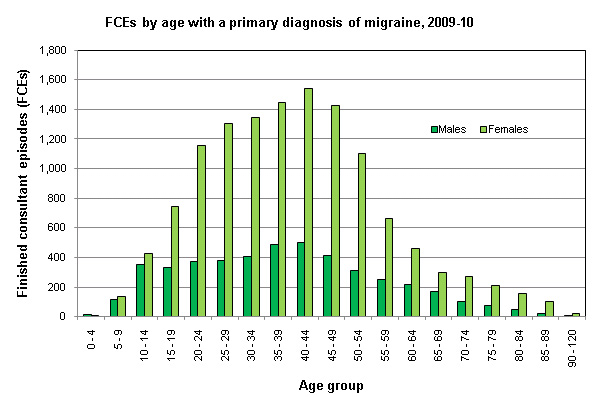IN THIS SITE...

- NHS Choices: Migraine
- The Migraine Action Association
- The Migraine Trust
HES on... Migraines
Migraines are recurrent, severe headaches that can last between 4 and 72 hours. This article gives an overview of the condition and highlights related 2009-10 HES data.
What are migraines?
Migraines are recurrent, severe headaches that may be accompanied by nausea, vomiting, and sensitivity to light and/or sound. It's not known what causes them.
Migraine attacks can last for between 4 and 72 hours, and can be split into five distinct stages (although not all need to be present):
- Prodromal (pre-headache) or early warning stage: this can include changes in mood, energy levels, behaviour and appetite, among other things
- Aura: the 'aura' is a neurological disturbance that can include visual disturbances, such as flashes of light, difficulty focusing and 'pins and needles', among other things
- Headache: a pulsating or throbbing pain on one side of the head, often accompanied by nausea or vomiting and extreme sensitivity to bright light and loud sounds
- Resolution stage: the attack gradually fades away, or in some cases stops suddenly after the person has been sick
- Postdromal (after headache) or recovery phase: exhaustion, tiredness and weakness.
Who do they affect?
According to the Migraine Action Association, migraines affect 1 in 7 people in the UK population, with twice as many women sufferers as men; a finding that HES data for England supports (see graph below). HES data also shows that hospital treatment due to migraines are most common among 20- to 54-year-olds.
 |
HES facts and figures
HES data for a primary diagnosis of migraines (diagnosis code G43 in ICD-10) shows that:
- most (86 per cent) hospital admissions for migraines are emergency admissions, rather than from waiting lists
- the average (mean) time that patients remained in hospital was 1.6 days
- most patients didn't undergo coded procedures. Where procedures were carried out, the most common was a diagnostic imaging of central nervous system (U05 in OPCS-4.6).
- it was responsible for 17,429 episodes of admitted patient care, accounting for 21,757 FCE bed days.
More information on this topic is available from NHS Choices here.

